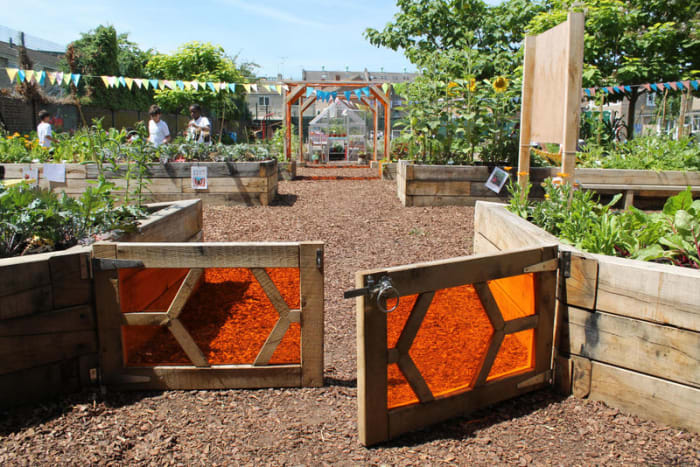This summer we’re celebrating our 100th Edible Playground. It’s a milestone for us as an organisation – one that we’re proud of – and it marks a good opportunity for us to look back and reflect on where we’ve come from and what’s been learnt along the way.
Back in 2009 we signed an agreement with our first Edible Playground flagship partner school: Rotherfield Primary in Islington. In the decade since, we’ve completed partnerships with schools in 12 towns and cities across the UK, involving around 2,700 teachers and impacting approximately 68,000 pupils. So what has the response from our historic partners been? What benefits have those 100 Edible Playgrounds brought to school communities?
Impact on the school community
We run regular surveys with our partner schools, and it’s apparent that the programme really does help teachers to teach and children to learn. A laudable 91 percent of teachers surveyed said that their Edible Playground had a moderate to significant impact on pupils’ real life and practical learning opportunities.
Some typical feedback we’ve had about the programme is that: 'It has given many children opportunities to fully take part with their class, which they are sometimes unable to do'.
Tracey Langridge, headteacher of Rockmount Primary School, told us in a recent conversation that: 'One thing we noticed was the impact that spending more time in the garden had on our more challenging children. Timetabling them an extra slot in the garden and giving them time out with nature really had a massive impact on behaviour and making them calmer'.
Paul Jackson, headteacher at Manorfield, gave similar feedback: 'The school was having low SATs results and poor behaviour and the Edible Playground gave us a focal point for overall school improvement. It had a huge impact on the children’s level of enthusiasm'.
Mental health, particularly among children, has been a hot topic recently, with more research being conducted into the extent of the challenge. It’s extremely satisfying to know that 86 percent of the teachers we’ve surveyed told us that their Edible Playground has had a moderate to significant positive effect on pupils’ moods, self-esteem and mental health.
But what about the children’s responses? Their feedback is arguably one of the most powerful barometers for success and from what we’ve heard, it’s all been positive:
'I love spending time in the Edible Playground, especially when I’m stressed, as it’s the most tranquil place'. Hebe, Year 5 pupil, Rockmount Primary School.
'I like eating healthily because having a good diet helps me concentrate in lessons. If I just ate fatty or sugary things, I would be distracted from my work. I grow food at home and at school, which is very nice and relaxing'. Miranda, Year 5 pupil, Rockmount Primary School.
'The fresh air wakes me up!' Ahsanur, Year 5 pupil, Manorfield Primary School.
Our surveys show that the Edible Playgrounds are clearly bringing lots of positives to the schools, with 82 percent of schools saying that the Edible Playground had had a moderate to significant effect on pupils’ physical health and 91 percent saying it had a moderate to significant impact on pupils’ knowledge of food and nutrition. 90 percent of our surveyed schools said they would recommend the programme to other schools.
Best practice
Speaking with teachers from historic projects has given a real insight into what works best for ensuring the success and sustainability of food growing programmes in schools. Top tips include:
- Timetabling regular slots in the garden for each class within the teaching day, rather than solely playtimes or after school
- Little and often is best, both for the garden itself, and for the benefits the children will get from it
- Choosing an outdoor learning champion – somebody who holds responsibility for the garden. Roles and responsibilities should be written into job descriptions to ensure they outlive staff changes
- Sharing responsibility. Some schools have developed outdoor leads from each year group. There is even scope to include the SLT, governors, parents and children as well. The more people involved, the more likely the project will work
- Having lesson plans designed with the food growing space in mind. This will allow the garden to be incorporated into the curriculum and become a full outdoor teaching resource. For advice on lesson plans and curriculum guides, head over to the Edible Playground resources here.
What’s next?
As we look towards the future we have ambitious plans to expand the programme across the UK. In 2019/20 we are aiming to complete 50 projects – a big step up from the 30 of 2018/19 – across a number of towns and cities including Bradford, West Bromwich, Nottingham and Newcastle. With aims to become the go-to source for information about food growing in schools, we will continue to provide functional, teacher-focused resources about how best to incorporate food growing into the curriculum.
Over the next few weeks, keep an eye out for the work we will be doing to celebrate our 100th Edible Playground. We have exciting plans to release some educational films and an impact report. We’ve also currently got a photography competition live. There are gardening vouchers up for grabs for schools that send us a photo showing what gardening means to them. Take a look herefor more information.















